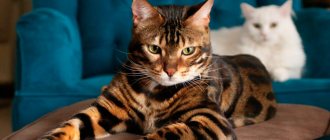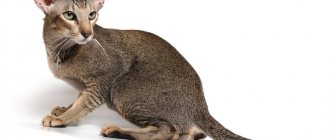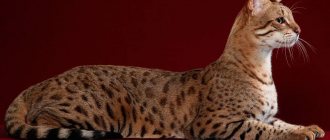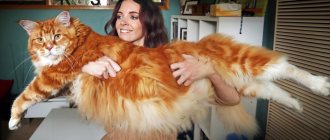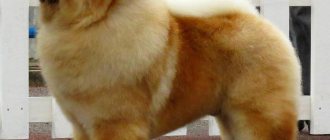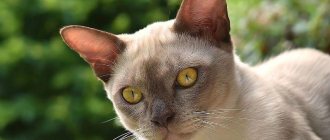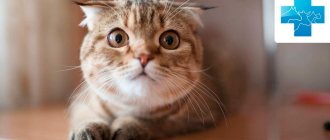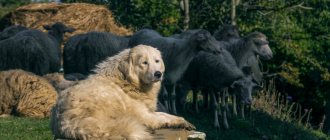Cats are independent creatures, freedom-loving, independent, and to some extent daring. Many breeders are convinced that their pets have higher intelligence than dogs. One can argue with this statement, but cats of some breeds are really unusually smart, cunning and quick-witted, they easily learn tricks, and sense the emotional state of their owner. We present the TOP 15 most intelligent and cunning cats according to felinologists and breeders.
Scottish lop-eared
If this cat hides somewhere among the grass, at first glance you can decide that there is an owl there. In addition to its characteristic appearance, its main feature is the ability to adapt to new people, an unfamiliar environment, and to any situation in the house, whether there is silence or the hubbub of many children.
He likes to sit next to his owner, but not on his lap (!). He will build a relationship with only one person, and he will get the most attention, he may even follow him around the apartment. But in return it will require the same attention in relationships.
Read the description and characteristics of Scottish Fold cats.
But she has her own type of yoga, and she likes to do it: lie on her back, stretch her legs forward and take a meditative pose, spread out like a rug. However, such a cute creature also has its own “claws” - she is incredibly stubborn.
Canadian Sphynx
Sphynxes are unusual cats. They have absolutely no fur. Nevertheless, this breed is considered one of the most popular among cat lovers. Sphinxes do not like loneliness, they become attached to their owner and can be trained. According to research, the intelligence of the sphinx can be compared to the mental abilities of a 3-4 year old child.
You can read about how to find out how old a cat is by human standards here:
Manifestations of a cat's mind
There is no single system by which one can measure the IQ of a pet. However, breeders note that some breeds learn faster, communicate more easily, have a good memory, and even try to respond to speech in their own way.
The intelligence of a representative of the cat family can be conditionally assessed by the following criteria:
- Ability to remember your name and other forms of address. If a cat does not react to a commanding tone and at the same time willingly responds to an affectionate call, then this indicates an extraordinary mind, capable of distinguishing intonations and approving or not of this type of address.
- The speed of accustoming to the tray, scratching post, eating in the designated place and being careful while doing so.
- Speed of reactions to external stimuli. How quickly a cat reacts to danger, stress, strangers, new objects in the house speaks of its insight.
- The ability to build logical chains and understand the cause and effect of actions and phenomena.
- Depth and durability of memory. Some pets can remember where their owners put food or toys and then try to get them in their absence. Particularly intelligent individuals remember the way home and the people they return to after tens of kilometers.
- Empathy and the ability to read the well-being and mood of others.
- The ability to choose an owner, distinguish him from other people, adapt to his lifestyle and character.
Like humans, a cat's intelligence is not a pure product of upbringing or a biological given.
Singaporean
Until the middle of the last century, cats were not favored in Southeast Asia, and this affected their character, in particular, Singapore cats.
They are still fearful and distrustful. But at the same time, the Singaporean woman has a relatively high level of intelligence - she loves to explore new places, she usually sets up a secluded place somewhere at the very top and watches everything that happens from there, and at the same time remembers everything she needs.
She firmly knows not only where her tray is, but even where the cache of food is located. But that is not all. Singaporean women are smart pets; with the right upbringing, they perceive commands not only by voice, by intonation, but also, as hard to believe as it may be, at just one glance.
The owners of these cats claim that they somehow manage to influence people. Well, that's an oriental trick. However, in conclusion, it must be said that for any owner, his pets are the smartest, the most affectionate, the nicest, and generally the very best.
9Maine Coon
The Maine Coon is the largest breed in the world, which is also included in the ranking of the smartest domestic cats in the world. You will be surprised, but these animals are also called philosopher cats. The composition of the mind of Maine Coons is unusual and not quite cat-like. They are contemplative, very insightful and extremely observant. Cats are wonderful and loving mothers. As soon as offspring appear, the Maine Coon mother immediately tries to isolate her children from people. Owners should not prevent such behavior - it is dangerous. Many owners note that cats come up with the most unimaginable tricks to protect their offspring. They also know human nature and the character of their owners very well and easily make it clear what they want. Sometimes it seems that representatives of this breed are smarter than people.
Ragdoll
The name of the Ragdoll breed translates to “rag doll.” These cats received this nickname for their unique ability to completely relax their muscles. Males weigh 7–9 kg, and females weigh 5–6 kg.
Did you know? This breed was first discovered in the 60s in America by Anna Baker. Her Persian-Angora cat Josephine was bred with a Birman cat. Anna Baker noticed that the kittens, when they were born, had the ability to relax their bodies when they grew up. She began to work closely on developing a new breed and in 1965 was able to secure the so-called “rag” gene at the genetic level and register this breed in the prescribed manner.
Ragdoll cats have the following features: wide-set oval eyes only blue, wedge-shaped head, powerful neck, nose always slightly upturned, small triangular-shaped ears set wide apart. Medium paws with pubescent pads, fluffy long tail.
The wool is medium length, has a small undercoat, is quite soft and similar to rabbit fur. The hind legs of representatives of this breed are, as it were, dressed in pants, and there is a fur collar on the neck. The most popular color is color point: the color is light, and there is a darker color on the face, paws and tail. The most common colors are light coffee with milk, chocolate, as well as gray-blue or deep purple.
These are quite calm and indifferent creatures. They are very good-natured and friendly. They do not like to strain their muscles once again, and when a conflict situation arises, they try to hide in a quiet place.
Ragdolls show affection towards their owner. They love to be petted, cuddled and expressed their admiration. These cats are not hunters - they will not catch mice or chase pigeons in the yard. They feel great inside a house or apartment. Cats of this breed get along well with children, other cats and dogs when living together.
Ragdolls do not tolerate loneliness well and become very bored if their owner is away for a long time. They may refuse food and water when upset. They simply need society.
Important! At the genetic level, Ragdoll cats are susceptible to a disease such as hip dysplasia. This disease can lead to paralysis of the hind limbs
The owner of a cat must clearly know the first signs of dysplasia: it is difficult for the cat to jump, when walking it begins to fall a little to one side, sometimes it is even difficult for it to put its paw.
These cats usually live 15–18 years.
Rating of the world's smartest cat breeds
The smartest cat breeds presented below meet all of the above criteria. They are highly trainable due to their innate intelligence and good memory, and are also distinguished by their extraordinary sociability and friendliness.
Canadian Sphynx
Canadian Sphynx cats have a good memory. They quickly remember new commands and understand the wishes of their owners perfectly. Sphinxes use dozens of different intonations to communicate, so with proper skill, their requests are quite easy to explain.
In addition to their developed mental abilities, these cats are notable for their canine devotion. Unlike most cats, they become attached exclusively to a person, and not to a place. Temporary separation from their owner frightens them much more than moving to a new home.
Thanks to their friendliness and playfulness, Sphynx cats quickly find a common language with children. They also treat other pets with enthusiasm, easily making friends even with dogs.
Munchkin
Curious and good-natured, munchkins are remarkable not only for their adorable little paws, but also for their excellent learning abilities. They have a special love for children. Cats take an active part in their games even in old age.
Despite the modest length of their legs, munchkins are not without jumping ability. Naturally, tall cabinets are beyond their control, so most often the little nimbles climb onto stools. But from this position, more interesting horizons open up for them.
Thanks to their developed intelligence, munchkins can easily get to the tasty treat on the top shelf, using a tricky sequence of objects standing in the way.
British
“The British” rarely please their owners by following commands, but not at all because of stupidity. These fluffies also boast high intelligence, but they use it only in their own interests.
Thanks to their self-sufficiency and calm disposition, the “British” easily tolerate temporary separation and never cause pogroms out of boredom. They prefer sleep to aimless destruction, but because of their laziness they often suffer from obesity.
The “British” are friendly towards children, but only if a certain distance is maintained. Rough treatment and overzealous expression of feelings are unacceptable to them.
Oriental
“Orientals” are often compared to aliens due to their unusual appearance and peculiar meow. Even their character is close to that of a dog. The classic arrogance and detachment of oriental breeds bypassed the “orientals”. Animals are extremely loyal to their owner and quickly understand the prohibitions he imposes.
Like munchkins, Orientals retain their playfulness into old age. When awake, they resemble a perpetual motion machine, so it is best to keep them in a spacious house.
Oriental cats are not without curiosity. They love to poke their nose into all the containers they find, as well as wide open any slammed doors.
Balinese
The ultra-communicative Balinese dogs cannot see life without their owners. They constantly follow them with their tail, so you can immediately forget about privacy with these pets. “Balinese” will accompany you to the bath and toilet with incredible enthusiasm, and will definitely settle down next to you when night comes. These animals especially love to sleep on the human head.
"Balinese" are playful and very jumping. For this reason, they are completely incompatible with fragile vases and indoor plants.
Developed intelligence helps the “Balinese” not only in mastering basic commands, but also in drawing up grandiose strategies. They often include other four-legged animals in their adventures, encouraging their participation with a piece of a stolen cutlet.
Despite periodic pranks, the “Balinese” understand prohibitions literally at a glance. After a one-time punishment, they are unlikely to run into a new one - but they can relapse if they are sure that they will definitely not get caught. Because of this, the bulk of destruction occurs during the absence of the owner.
Siberian
Representatives of this breed are one of the most popular mustachioed pets in Russia. They live a long time and have a very calm character. Despite all their friendliness, “Siberians” respect personal space and do not bother a person if he is not in the mood for communication.
Unlike oriental cats, “Siberians” are not talkative, but they are also capricious and subject to mood swings. They love to play around with kids and play outdoor games, but do not tolerate rudeness towards themselves.
Those who lack tact may also fall into disfavor. If you do not want to become an enemy of the “Siberian”, then show him the same tact. Do not disturb him during sleep and do not pick him up against his will.
Thanks to their high mental abilities, “Siberians” easily master simple commands and quickly become accustomed to the litter box. They are best at fetching a ball and other small objects, since their hunting instinct is developed to the maximum extent. For this reason, rodents almost never appear in the house where the “Siberian” lives.
Siamese
"Siamese" are one of the most wayward and demanding breeds. Most often, they choose only one beloved owner. The Siamese treat everyone else either condescendingly or openly hostile. Jealousy is no stranger to them. Because of this, they rarely find a common language with other four-legged animals.
The high intelligence of these cats is confirmed by their developed long-term memory. “Siamese” remember offenders for a long time and like to take them by surprise with delayed revenge.
Despite a slightly exaggerated ego, representatives of this breed are not devoid of tenderness. They have a special love for conversations. To communicate with their owner, Siamese use not only different sounds, but also intonations. They also understand human emotions well, so an angry and rude voice can seriously offend them and even make them depressed.
Abyssinian
The Abyssinians are no less intelligent. They quickly get accustomed to the tray and scratching post. Digging soil from pots and riding on curtains are also not typical for them. The animal remembers all prohibitions in early childhood if the owner pays attention to its upbringing.
“Abyssinians” treat children patiently. They do not release their claws during games, and if the child exceeds his authority, they simply proudly walk away.
Due to hyperactivity, Abyssinians quite often fall out of windows. For this reason, when keeping these pets, it is necessary to install a protective “anti-cat”.
Maine Coon
Like Siberians, Maine Coons are excellent mousecatchers. Despite a dog's devotion, they prefer to keep a certain distance in relationships. Of all the household members, Maine Coons choose only one favorite.
Thanks to their high intelligence, these pets remember not only voice commands, but also gestures. They are also quite good at manipulating people.
Maine Coons are not prone to pampering, but due to their gigantic size they often cause unintentional destruction. For this reason, it is better to store all fragile items high up and under lock and key.
Norwegian forest
Norwegian forest cats are inquisitive and have an excellent memory. Despite their high intelligence, it is almost impossible to teach them even the most basic commands. The whole point is that animals completely refuse to obey the whims of others and are guided only by their own desires.
Norwegian forest cats are friendly towards other pets and children. They do not show aggression even with outright provocations. Instead, the animals proudly retire to a secluded corner where no one can reach them.
Representatives of this breed are best kept in a country house due to their large size and innate activity. It is also important to note that Norwegian forest cats are prone to “vagrancy”. They can disappear on the street for several hours or even a whole day, but they always return.
Despite their innate independence, animals become strongly attached to humans, but only to one. It is with him that they spend most of their free time.
Raising a smart, obedient and kind pet
Unlike dogs, cats are more independent. They are not guided by blind trust in a person, so you should first gain their respect - and only then interest them in learning.
Training mustachioed pets should take place exclusively in a playful way. Otherwise, the animal will quickly lose interest.
Also, you should not exercise when you are in a bad mood, too often or for too long. The easiest way is to focus on what your pet likes. If the “mustache” gravitates towards hunting, then he will quickly master the “Fetch” command.
Try to be patient and never resort to shouting or physical assault. Pay special attention to successes. Encourage even the smallest achievements. This will not only increase interest in your activities, but will also help strengthen your relationships.
Do you like the article? 0
What is meant by the term “cat loyalty”
The most telling example of a cat's fidelity is the boundless and reverent care of a mother cat for her growing kittens. Her love for the kids is unconditional, so she will sacrifice her life without hesitation to save them.
From a scientific point of view, such recklessness can be explained very banally - by nature’s instinct of conservation for the survival of its kind. Logic here recedes only in one case - when saving people. Cases of attacks by mustachioed pets on robbers and wild dogs to protect their owners are confirmed not only by eyewitness accounts, but also by video recordings. Such strange and life-threatening behavior is a manifestation of that very loyalty.
Despite the evidence, you should not expect an extreme situation. In ordinary life, the affection of a “mustache” can be determined by simpler signs:
- quick response to nickname and other calls;
- accepting affection and invitations to play;
- mandatory return home after a walk (relevant for free-ranging animals);
- giving gifts (bringing killed mice and birds);
- cat “kisses” and “milk step”;
- taking free and relaxed poses while sleeping (showing your tummy);
- meeting after a long absence.
A cat’s innate independence precludes building relationships similar to canine subordination. Cats communicate with their owners strictly on equal terms, but they also become attached to them and are very sad after their death.


